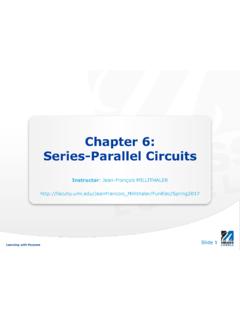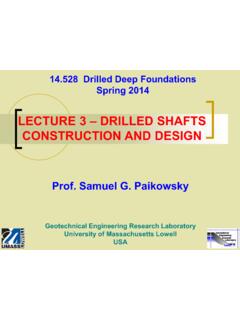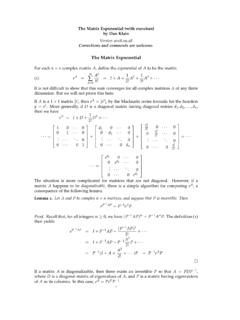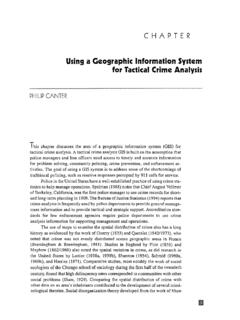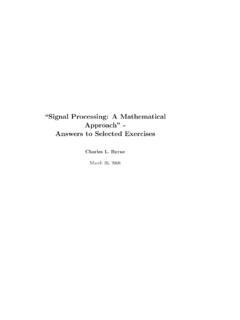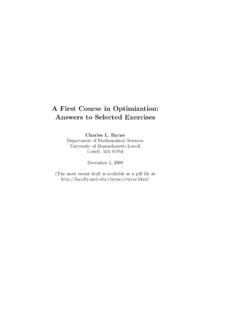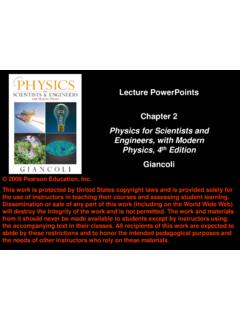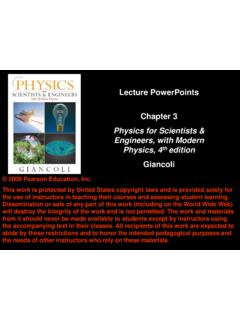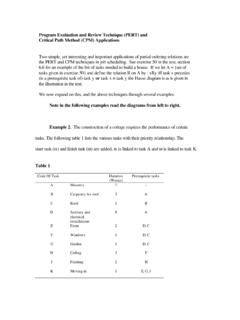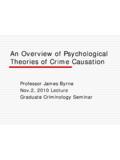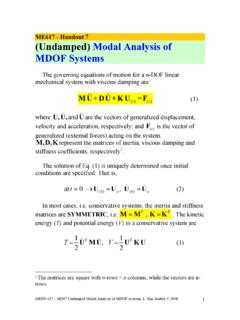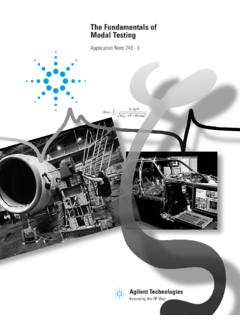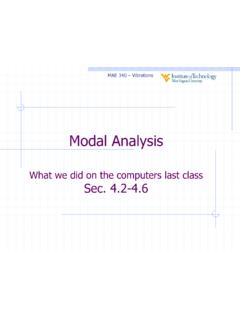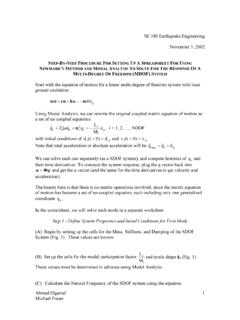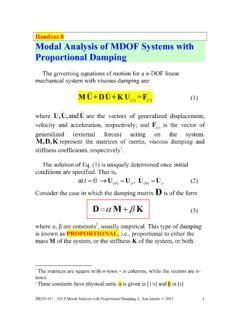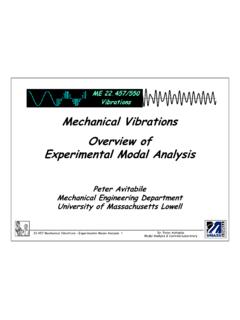Transcription of MDOF review 061904 - University of Massachusetts Lowell
1 1Dr. Peter AvitabileModal analysis & Controls review MDOF TheoryReview MDOF TheoryPeter AvitabileMechanical Engineering DepartmentUniversity of Massachusetts Lowell [ K ]n[ M ]n[ M ]a[ K ]a[ E ]a[ ]2 Structural Dynamic Modeling Techniques & modal analysis Methodsmk11c1mp33c3mk22c2f3k3p2f2f1p1 MODE 1 MODE 2 MODE 32Dr. Peter AvitabileModal analysis & Controls review MDOF TheoryMultiple Degree of Freedom Systems Referred to as a Multiple Degree of Freedom An NDOF system has N independent degrees of freedom to describe the system There is one natural frequency for every DOF in the system descriptionSystems with more than one DOF:3Dr. Peter AvitabileModal analysis & Controls review MDOF TheoryMultiple Degree of Freedom Systems Each natural frequency has a displacement configuration referred to as a normal mode Mathematical quantities referred to as eigenvalues and eigenvectors are used to describe the system characteristics While the resulting motion appears more complicated, the system set of equations can always be decomposed into a set of equivalent SDOF systems for each mode of the of a MDOF system:4Dr.
2 Peter AvitabileModal analysis & Controls review MDOF TheoryMultiple Degree of Freedom Systems lumped mass stiffness proportional to displacement damping proportional to velocity linear time invariant 2nd order differential equationsAssumptionsmmkkcc112212f1f2x1x2 5Dr. Peter AvitabileModal analysis & Controls review MDOF TheoryMultiple Degree of Freedom SystemsFree body diagramf1f2(k2x1x2)-(c2x1x2)-x1x2k1x1c1x 1m2m16Dr. Peter AvitabileModal analysis & Controls review MDOF TheoryMultiple Degree of Freedom SystemsNewton s Second LawRearrange terms()()()() () ()1221222221221112211111xxkxxctfxmxxkxkx xcxctfxm = + + =&&&&&&&&&()()()()tfxkxkxcxcxmtfxkxkkxcx ccxm222122212221221212212111=+ + = ++ ++&&&&&&&&f1f2(k2x1x2)-(c2x1x2)-x1x2k1x1 c1x1m2m17Dr.
3 Peter AvitabileModal analysis & Controls review MDOF TheoryMDOF Equations of MotionEquation of Motion for 2 DOFcan be written in compact matrix form as()() = ++ ++ )t(f)t(fxxkkkkkxxcccccxxmm21212222121222 212121&&&&&&[]{}[]{}[]{}{}FxKxCxM=++&&&M atrices and Linear Algebra are important !!!8Dr. Peter AvitabileModal analysis & Controls review MDOF TheoryMDOF Equations of MotionThis coupled set of equations can be uncoupled by performing an eigensolution to obtain eigenpairs for each mode of the system, that is eigenvalues and eigenvectors or frequencies (poles) and mode shapes 9Dr. Peter AvitabileModal analysis & Controls review MDOF TheoryMDOF Equations of MotionEquation of Motion[]{}[]{}[]{}{})t(FxKxCxM=++&&&Eige nsolutionFrequencies (eigenvalues) and Mode Shapes (eigenvectors)[][][]{}0xMK= []{}{}[]L2122212uuUand\\\= = 10Dr.
4 Peter AvitabileModal analysis & Controls review MDOF TheoryMDOF - Orthogonality of EigenvectorsNormal modes are orthogonal with respect to the system mass and stiffness eigen problem can be written asFor the ith mode of the system, the eigenproblemcan be written as[][][][][]2 UMUK =[]{}[]{}iiiuMuK =11Dr. Peter AvitabileModal analysis & Controls review MDOF TheoryMDOF - Orthogonality of EigenvectorsPremultiply that equation by the transpose of a different vector ujand write a second equation for ujand premultiplyit by the transpose of vector ui {}[]{}{}[]{}iTjiiTjuMuuKu ={}[]{}{}[]{}jTijjTiuMuuKu =12Dr. Peter AvitabileModal analysis & Controls review MDOF TheoryMDOF - Orthogonality of EigenvectorsSubtracting the previous two equations, yieldsSince the eigenvalues for each mode are different,When i=j, then the values are not zero(){}[]{}0uMujTiji= {}[]{}{}[]{}jikuKumuMuiiiTiiiiTi= =={}[]{}ji0uMujTi =13Dr.
5 Peter AvitabileModal analysis & Controls review MDOF TheoryModal Matrix and modal Space TransformationDefine the modal matrix as the collection of modal vectors for each mode organized in column fashion in the modal matrixThis modal matrix is then used to define the modal transformation equation with a new coordinate with p as the principal coordinate[]{}{}{}[]L321uuuU={}[]{} { } { }[] ==ML2121ppuupUx14Dr. Peter AvitabileModal analysis & Controls review MDOF TheoryModal Space TransformationSubstitute the modal transformation into the equation of motionIn order to put the equations in normal form, this equation must be premultiplied by the transpose of the projection operator to give[][][]{}[][][]{}[][ ][]{}[]{}FUpUKUpUCUpUMUTTTT=++&&&[][]{}[ ][]{}[][ ]{}{}FpUKpUCpUM=++&&&15Dr.
6 Peter AvitabileModal analysis & Controls review MDOF TheoryModal Space TransformationThe first term of the modal acceleration can be expanded as[][][]{}[]{}(){}[]{}(){}[]{}(){}[]{}() {}[]{}(){}[]{}(){}[]{}(){}[]{}(){}[]{}() =OMMMLLL3T3T31T33T22T21T23T12T11T1 TuMu2uMuuMuuMuuMuuMuuMuuMuuMuUMU16Dr. Peter AvitabileModal analysis & Controls review MDOF TheoryModal Space TransformationRecall from orthogonality that{}[]{}ji0uMujTi =so that[][][]{}[]{}(){}[]{}(){}[]{}() =OMMMLLL3T32T21T1 TuMu000uMu000uMuUMU17Dr. Peter AvitabileModal analysis & Controls review MDOF TheoryModal Mass, modal Damping, modal StiffnessThe mass becomesThe stiffness becomesThe damping becomes (under special conditions)[][][] =OMMMLLL332211Tm000m000mUMU[][][] =OMMMLLL332211Tk000k000kUKU[][][] =OMMMLLL332211Tc000c000cUCU18Dr.
7 Peter AvitabileModal analysis & Controls review MDOF TheoryUnit modal Mass ScalingThe mass orthogonality results in an arbitrary mass called the modal massIt may be desirable to scale the mode shapes so that the modal mass is mode shape must be scaled by the inverse of the square root of the modal mass{}[]{}iiiTimuMu={}[]{}iiiTimuMu=19Dr . Peter AvitabileModal analysis & Controls review MDOF TheoryUnit modal Mass ScalingEach mode can be conveniently scaled as follows[] [] =OMMMLLL332211nm1000m1000m1UU20Dr. Peter AvitabileModal analysis & Controls review MDOF TheoryScaled Unit modal Mass, Damping, and StiffnessModal MassModal DampingModal Stiffness[][][] =OMMMLLL100010001 UMUnTn[][][] =OMMMLLL232221nTn000000 UKU[][][] =OMMMLLL332211nTn200020002 UCU21Dr.
8 Peter AvitabileModal analysis & Controls review MDOF TheoryModal Space TransformationThe physical set of highly coupled equations are transformed to modal space through the modal transformation equation to yield a set of uncoupled equations modal equations (uncoupled){}{}{}{} = + + MMM&&M&&&&FuFupp\kkpp\ccpp\mmT2T12121212 1212122Dr. Peter AvitabileModal analysis & Controls review MDOF TheoryModal Space TransformationDiagonal Matrices - modal Mass modal Damping modal StiffnessHighly coupled systemtransformed into simple system{}{}{}[]{}FUp\K\p\C\p\M\T= + + &&&mk11c1mp33c3mk22c2f3k3p2f2f1p1 MODE 1 MODE 2 MODE 323Dr. Peter AvitabileModal analysis & Controls review MDOF TheoryModal Space TransformationIt is very clear to see that these modal space equations result in a set of independent SDOF systemsThe modal transformation equation uncouples the highly coupled set of equationsThe modal transformation appropriates the force to each modal oscillator in modal spaceThe modal transformation equation combines the response of all the independent SDOF systems to identify the total physical response 24Dr.
9 Peter AvitabileModal analysis & Controls review MDOF TheoryModal Space Response AnalysisSince the MDOF system is reduced to equivalent SDOF systems with appropriate force, the response of each SDOF system can be determined using SDOF approaches discussed thus total response due to each of the SDOF systems can be determined using the modal transformation equation 25Dr. Peter AvitabileModal analysis & Controls review MDOF TheoryModal Space Transformation[ M ]{p} + [ C ]{p} + [ K ]{p} = [U] {F(t)}Tmk11c1f1p1 MODE 1mk22c2p2f2 MODE 2mp33c3f3k3 MODE 3 MODALPHYSICAL MODEL[M]{x} + [C]{x} + [K]{x} = {F(t)}{x} = [U]{p} = [ SPACE{x} = [U]{p} = ++{u }p 33{u }p 22{u }p 11{u } 3{u } 2{u } 1]{p}.
10 ++ =26Dr. Peter AvitabileModal analysis & Controls review MDOF TheoryNumerical Response - Mode SuperpositionUsing the modal space formulation, a simple integration on the SDOF system can be performed{}{}{}{} = + + MMM&&M&&&&FuFupp\kkpp\ccpp\mmT2T12121212 12121m k 1 1 c 1 f 1 p 1 MODE 1 m k 2 2 c 2 p 2 f 2 MODE 2 m p 3 3 c 3 f 3 k 3 MODE 3 {x} = {x} = {x} = {u }p 1 1 {u }p 2 2 {u }p 3 3 + {x} = [U]{p} = + + {u }p 3 3 {u }p 2 2 {u }p 1 1 + = 27Dr. Peter AvitabileModal analysis & Controls review MDOF TheoryModal Space - modal Matrices[][][] =\M\UMU111T1[][][] =\C\UCU111T1[][][] =\K\UKU111T1 modal StiffnessModal DampingModal MassThe mode shapes are linearly independent and orthogonal the mass and stiffness matricesTRUE !
